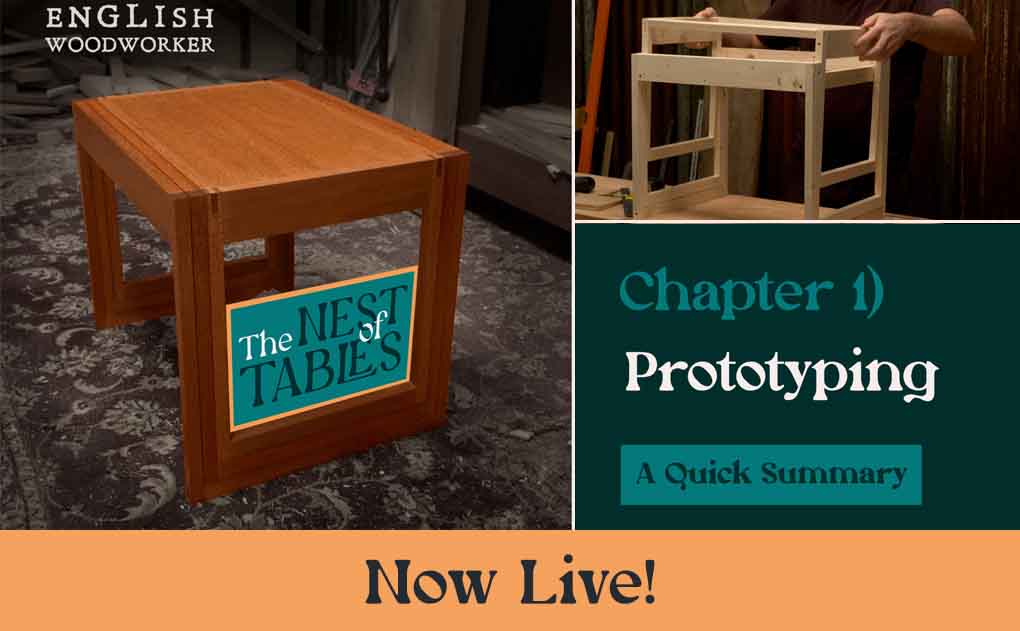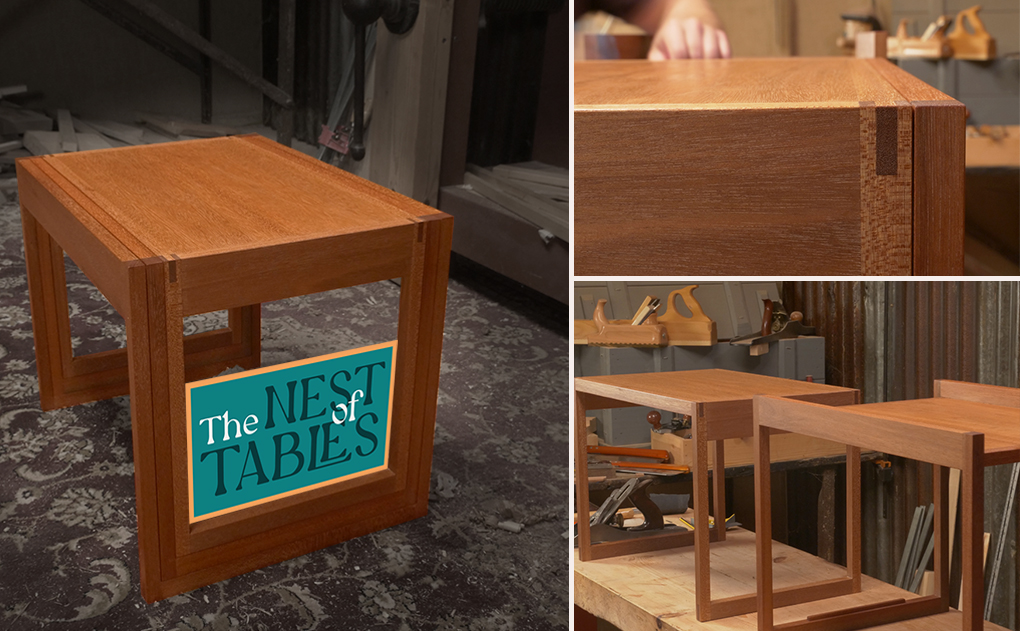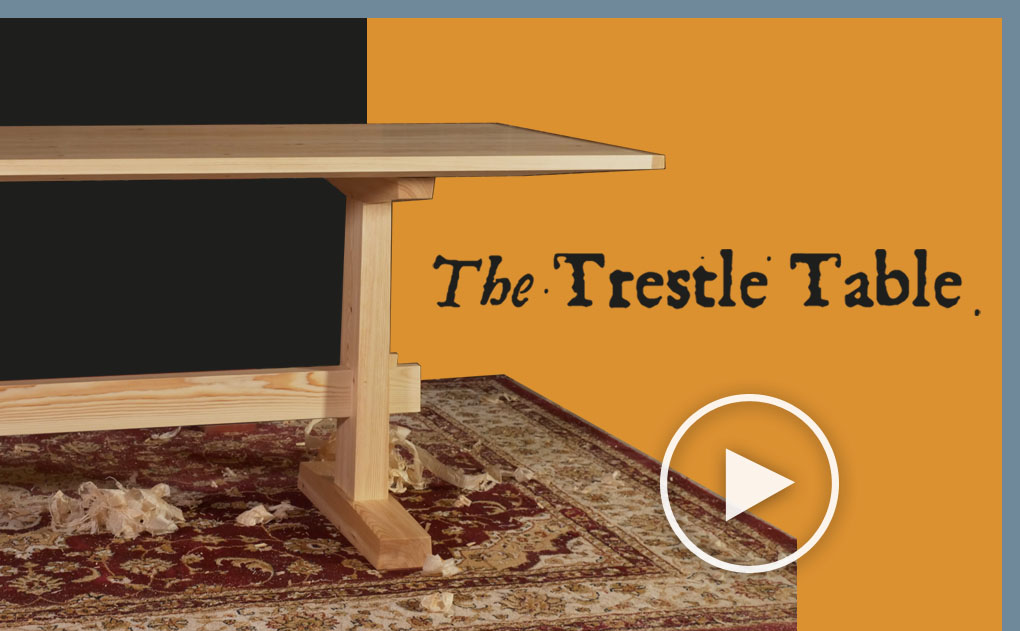Make Use Of Your Offcuts & Learn to Weave… all While Building This Delightful Danish Stool!
[Update:]This series has now completed. The videos take you step-by-step through the build, including how to weave the seat (Watch the intro above).
The series can be purchased by Clicking Here
If you’re already a Member then you may need to Login first
You asked us for another ‘one board project’, and this is what we came up with.
It’s a popular request;
“Can we create a project that needs just one board to build?“
Well this stool should certainly tick that box because the whole thing was built from little more than a 2′ chunk of wood.
And it’s been designed to be versatile. You could rip 1″ wide strips from a 2″ thick board, or vice versa.
So not only is it less than a ‘one board project’, but it could be an ideal build to make use of some offcuts you’ve got laying around already.

The Danish Stool Design
This build is deceptively complex.
The challenge with coming up with a build that uses minimal timber is making sure it looks somewhat impressive when it’s done! We wanted a proper piece of furniture, not something naff that looked like it had been knocked up out of some old pallet wood!
The stool is small, which makes it a fast build particularly at the prep stage. But every joint within it is angled, and as the piece comes together those angles can cause a bit of head scratching.
The build becomes a fantastic exercise in practicing angled joints.
We discuss why they all need approaching differently, and cover a few tricks to ensure that in each situation the resulting joint is crisp and strong.

The Hand Tools
Our usual basic kit of hand tools will cover your needs for this build.
I’ve treated myself to some new Japanese saws and so for the sake of showing a different approach I saw rather than split the tenon cheeks through this build. Of course if you prefer you can certainly stick with splitting.
Other than the usual list of hand tools I’ve also used a bandsaw to speed up the prep. If you don’t have one though then it’s a very manageable project to rip out by hand as we’ve done in the past.
The tool kit itself can be incredibly minimal:
- The usual marking & measuring tools.
- Joinery Saws. For ripping and crosscuts.
- A Jack Plane. (Different irons may be required for roughing & smoothing).
- Chisels. Strong bevel edge for morticing, plus for paring and fettling.
- Router Plane. Optional, but a fantastic addition for fine tuning joinery.
- Mallet | Drill (I opted for electric) | Clamps.
The Techniques
We show the full build from rough board to finished stool.
Along the way we go through everything from prepping the stock to shaping each component.
All of the joinery is mortice and tenons, and every joint shows a different situation –
Sometimes we angle the mortice, sometimes we angle the tenon. And every time the marking and fitting needs a different approach. The thought process behind each decision is also explained as we go.
Weaving The Seat
We detail the entire process of weaving the seat from start to finish. If you haven’t done this before I think you’re going to find it’s a wonderful skill to add, especially if you enjoy creating your own designs.
The process is easy to learn, but it does require plenty of focus and time to execute it with strength and neatness. It’s worth it though, once it’s finished the result can be very beautiful and adds a wonderful depth to the build.
We’ve used a 3mm black Danish paper cord to be authentic with the weave, although almost any cord would do the trick here.
See here for more details of what you’ll find in each of the videos.

The Videos
There are seven chapters in total.
[Update:] The series is now complete. All videos are available for immediate access to stream &/ or download.
A cutting list and full PDF plans are also included.
The series can be purchased HERE
If you’re already a Member then you may need to Login first
For further details on what’s covered in each of the videos, have a look here.
Not familiar with our Videos?
We make online courses that provide tuition on hand tool woodworking.
The detailed videos can be both streamed and downloaded.
As a professional hand tool woodworker, we aim to get you feeling inspired to build, and equipped with the knowledge to tackle projects entirely by hand.
View our full Collection of Video Series HERE
Or sign up to our Free Plane Build Mini Series HERE





Fine, you’re back. Ordered immediately. 🙂
Unfortunately you didn’t keep your word regarding the paint video. 🙁
Thanks Marc 😊,
The paint video has been filmed as planned. Helen’s been busy with loads of new stuff but it’s working its way through her editing backlog.
The prodigal son has returned! This looks pretty complex, but I do have a bunch of scrap of really nice white oak leftover from another project.
Hi Steve,
It’s complex if you think about too much of it at once, but it’s not too bad once you break it down and really get your head on the job when you’re marking out the joints.
Alright, you talked me into it. Worst case is I increase my skill level !
Always a pleasure to see you around, Richard! Looking forward to the build.
Hi Richard, this sounds like fun! I’m looking forward to weave. Maybe I’ll get me a bow saw for this project. (For ripping and cutting the curve.)
Hi Richard and Helen
Great to hear from you again and with the winter months coming what a great time to get into the workshop a bit more than of late.
Greatly looking forward to it and will raid the wood store to see if I can find suitable material rating than buying at today’s inflated prices.
rather than not “rating than” oops
Of all the videos I’ve watched over the years, I enjoy yours the most.
How nice to hear a new series is starting! I’m just finishing a dining table based on your Hall Table video. It’s much larger, no drawer, and made of curly maple which is impossible to plane or joint on a machine! I ended up hand planing everything with a very close cap iron setting which worked great. Thank you for that tip.
I’ve purchased the new video series as the angled tenons and mortices looks very interesting. I hope you will sometime do a series on a proper chair design with information on designing a chair for comfort and strength without being clunky. Best wishes to you and Helen.
I really like the looks of this, and the smaller size; yet with lots of detail and complexity. Glad to get more of your work! Glad to hear about the paint video.
I’m signing up for this one, love the design. Really excited to find a different use for my cut offs besides cutting boards and coasters!
Do you think a beginner can build this stool?
This project looks like something very good, not to mention a little different, for those months leasing us tp Christmas. Naturally, I ordered immediately and set out to the necessary wood. I can’t wait to get started.
Make that ‘leading up to Christmas.”
Nice to have you back, and this looks like a great project. I’ll be purchasing the video, but wanted to mention that the hyperlinked text above (“See here for more details of what you’ll find in each of the videos”) is resulting in a 404 page for me, in case others are experiencing the same.
Series purchased before I saw the intro video. I just KNOW that Richard and Helen delivers. Every. Single. Time!
The best educator in the woodworking community is at it again. Why do I say “the best”? Because you show different ways to skin a cat. You use both nice, modern (and at times expensive) tools, as well as old can opener candidates. From a Veritas router plane to a throw-away carpenter’s saw. All presented with a no-nonsense approach, a bit of humor, delightful and varied lingo and without any perceivable bias or self-indulging nonsense like so many others.
It’s a shame you don’t do educating full time, Richard – I’d pay for it! But in the end, it’s the butter on your toast that counts.
I do miss short Youtube content, though. Or a patreon thingy where one pays for access to content. I’d subscribe in a heartbeat!
Question: how about scaling this thing to, say 1 meter in width? Can one swap the seat with a foam cushion thing on a piece of ply? I’m just looking for options. 🙂
I miss the short Youtube videos also so I watch the old stuff.
As I understand it the woven seat is integral to the structure of the stool. The weight of a person sitting on a flexible seat results in an inward force vector that pulls the joints tighter together. A rigid seat pushing down on the legs would tend to rack the joints open, especially since the legs are splayed outwards.
You do some nice work. I enjoy the commentary. Sometimes I wish you explain some of the phrases for us in the US 😉
It took me a while to catch on to some of his sayings and I find them special and always make me smile. The idea that he should explain some of his comments like “tarting up a board” would only be possible if he was capable of knowing what is understood and what is not. He is a great woodworker and a fantastic teacher not a mindreader. Hang in there, you will catch on sooner or later.
I was joking about the comments.
While to wood for the project is already waiting to be tackeled in my garage, I’m having trouble ordering the black paper cord in/from Germany.
Would a 120m spool enough for the stool?
Another option would be dyeing the wood in black (like the base of the sidetable video) an go for beige cord…
Do you think a beginning woodworker can make this stool?
Hi Leslie,
Yes, a beginner woodworker can do this – but he or she must spend time doing things right. Double- and triple checking everything, and be prepared to waste a bit of wood when (not if) one hits a bit of a snag. Do things in exactly the same order as Richard does (there is madness to the reason, or the other way around..).
The one thing I would recommend a beginner should focus on the most, is SHARP tools! And I mean sharp! The other day I was retracting the blade on my router plane. It slipped, and since I was a utter bonehead at that moment – it fell 2 centimetres and the blade nicked a fingertip. Grazed it, really. Not even the full weight of the plane, still it cut me good. And a clean cut at that. I haven’t checked, but I think the wound is dead square.
Anyway, I am grossing you out by saying this to tell you that you need VERY sharp tools. If you can manage that (it is not very hard to do, check Richard’s video series on the topic, it is very good! I do recommend investing in diamond plates, though. Lasts longer, no upkeep to keep them flat where you need that); If you can manage to get really sharp tools, your work will improve. Dull tools means that your mortises and tenons won’t be that tight. The shoulders won’t be crisp, and you’ll have tiny gaps here and there.
It would behoove you to do a test; make the two mortises and tenons for one leg (ignore the compound angles, make them square the first time). By doing that, you won’t be surprised later. The different angles is no more complex than getting things square, soon as you can wrap your head around it. 🙂
Undercut your tenon shoulders, sneak up to the fit, make the tenons fit the mortise, not the other way around.
You’ll manage just fine. 🙂
I see you are making this from oak. I am kind of tired of kiln dried oak as if feels so unsympathetic to work with. I was pondering cherry or cedar (depending on what I can find). I know they are softer but will they be suitable and strong enough?
Try fir, spruce, or hemlock. They are strong and lovely to work. Cedar is nice, but for me it has a fuzzy feel and is not satisfying to work.
I enjoyed looking at the process of your project. I am learning a lot from you.
I think this would be a good “next” project for me. I’ve been looking in to learning cane, rush, and other woven seating types so this black cord should fit right in. Could probably use rush as well. Although thicker it may be a bit cumbersome but will do in a pinch if you can’t find the black cord.
Richard,
Thanks for this series of videos on the stool build.
Merry Christmas and Happy New Year
For you and Helen
Already looking forward to see 2022’s and what you folks have lined up..
Thanks again
I made this. It was good fun. Used a lot more stationary tools and was grateful for them. Would post pics if possible.
Also, the weaving left my hands and forearms feeling like I fed them through a wood chipper. Still fun.
Exactly what do you mean by “stationary tools?” I’m curious.
Jointer, planer, bandsaw, table saw. The biggies, I guess. A router table was really helpful for template routing and getting repeatable results. I finally got a better router table setup (Jessem – supply chain issues) for the 2nd build and that really help. The 2nd and 3rd copies I made of this were much simpler because I’d figured out some machine tricks to really lower the hand labour.
Also, it’s a luxury that I picked up at a garage sale (where I get most of my tools), but I used an oscillating edge sander for a lot of the leg shaping which cut the time by about 9/10ths.
I also used a 22.5 degree router bit to do a lot of the early shaping on the legs/top aprons when I made a second batch and it resulted in a more uniform and visually pleasing result.
For finish, I used Osmo Poly-X and the white oak came out really nice.
I’m just waiting for the finish to cure for the two I just finished, then its time to weave. My hands are not happy about the prospect, but I am.